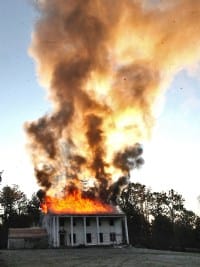Lead levels in soil not actionable in area of flake fall after fire, Bloomington’s contractor says

According to the city of Bloomington, soil samples taken from properties where debris fell after the Nov. 5 controlled burning of a house at 1213 High Street do not show lead levels that are “actionable.”

The debris included flakes of lead-based paint that coated the siding of the house.
The announcement, about the result of lead tests on soil samples taken by VET Environmental Engineering, came in a news release issued by the city of Bloomington late Tuesday afternoon.
The conclusions in Tuesday’s news release are based on results of testing done so far.
The new release says that lead levels in soil samples taken in the area where debris fell do not exceed Indiana Department of Environmental Management (IDEM) limits “for residential or direct contact exposure, and are in keeping with IDEM’s survey of background lead concentrations in Indiana.”
According to Tuesday’s news release, none of the samples showed lead levels greater than 200 parts per million (ppm). According to Bloomington’s news release, IDEM requires action to be taken if lead levels exceed 400 ppm.
The news release does not provide specifics about how many soil samples were done or what the specific lead levels were in those samples. Responding to an emailed B Square request for a list of the soil samples with their lead concentrations, the city’s director of communications Yael Ksander indicated that more specific information would be forthcoming.
“VET will provide the written report with levels soon—but they gave us this statement as soon as the first few samples were returned, and we wanted to get that info out as soon as we could to reassure the public,” Ksander wrote.
Helping with the testing of some of the material connected with the controlled burn are Gabriel Filippelli, who’s a biogeochemist and director of the Center for Urban Health at IUPUI, and two of his graduate students, John Shukle and Leah Wood.
Earlier, Filipelli’s team confirmed the existence of lead, in very high levels, in the paint flakes that fell on the neighborhood to the west of the High Street burn.
Filipelli is also planning to do soil testing, but does not expect them to show high levels of lead. Responding to an emailed question Tuesday evening, he wrote: “We are taking soil samples, but do not expect them to be elevated above the action level given the characteristics of this neighborhood.”
About VET’s test results, Filipelli wrote, “[T]heir findings were exactly what I would expect…”
In addition to more lead test results from soil samples, results of lead testing on blood samples, taken from firefighters involved in the cleanup, are also expected to be released sometime soon, according to Tuesday’s news release.
According to the news release, Bloomington firefighters are being trained by Monroe County’s health department to test residents who want to check their blood for lead levels.
The news release quotes Monroe County health administrator Penny Caudill saying, “We have consulted with public health officials and based on the current data and work completed, the homeowners should be able to proceed with fall lawn care as they normally would.”
The quote from Caudill continues, “Wearing gloves, washing up when the work is done and perhaps wearing a mask should allow the work to be done with little, if any risk.”
If any visible paint flakes are found, they can be thrown in the normal household trash, according to Tuesday’s release.




Comments ()